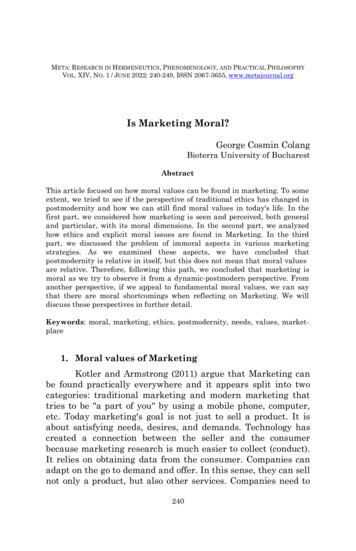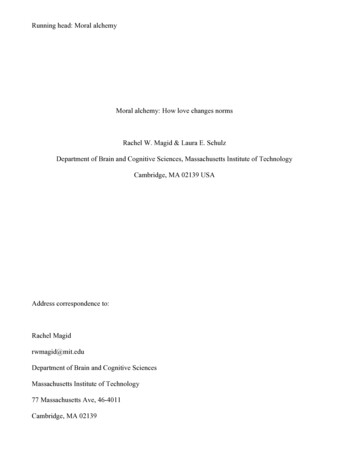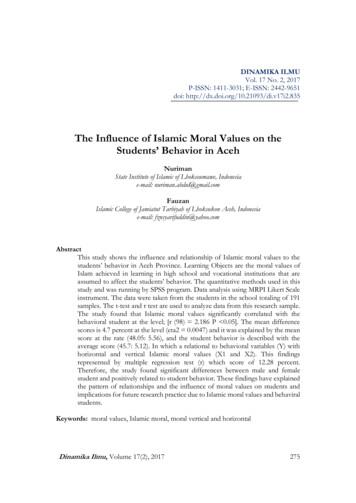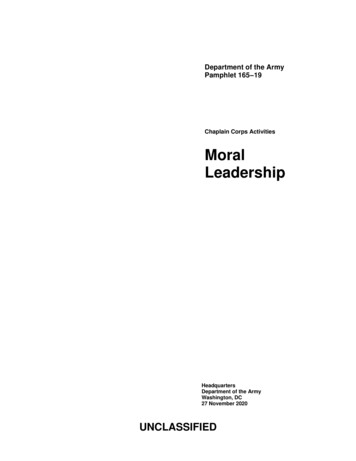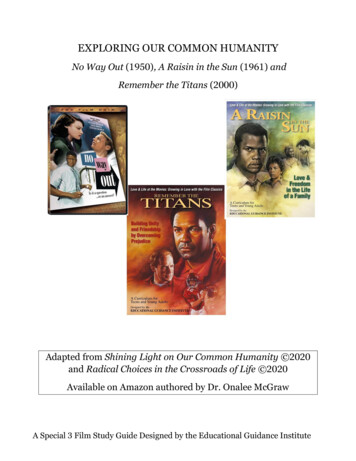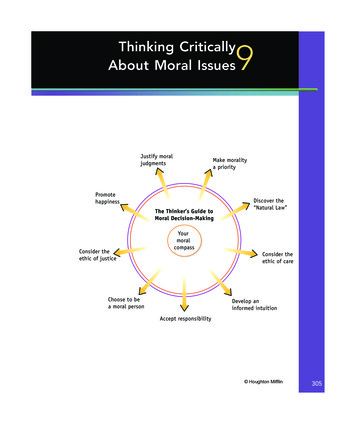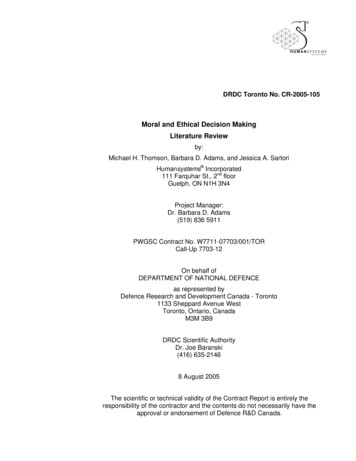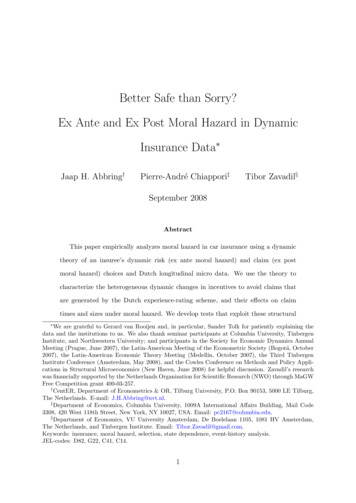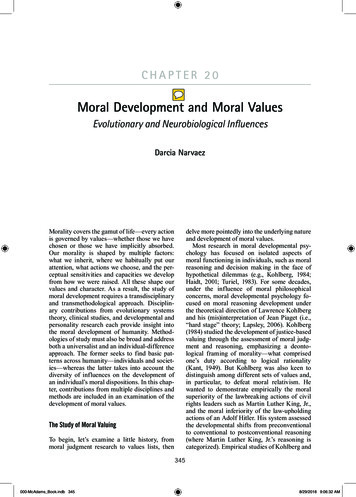
Transcription
& Reed, 2002).In another line of research examining thetypes of values individuals profess, Rokeach(1979) identified lists of terminal values (e.g., aworld of beauty, wisdom) and instrumental values (e.g., love, obedience), and determined thatindividuals prioritize them differently. More recently and more systematically, Schwartz (1992,2005) identified a set of 10 values, tested themin 67 countries, and found similar distinctivestructures across nations, and different culturalmotivational patterns. The values are placedinto four main categories: openness to changeincludes self-direction and stimulation; selfenhancement includes hedonism, achievement,and power; conservation is described by security, conformity, and tradition; self-enhancementembraces benevolence and universalism. Alsointerested in cultural differences and based onShweder’s (1993) earlier work contrasting theUnited States and India, Haidt (2012) focusedattention on group differences in five (then six)values that he called moral foundations: Thoughmost ethical traditions emphasize fairness andcaring for others, values of liberty, purity, hierarchy, and ingroup over outgroup are alsohighly prized by some individuals and groups.In fact, the latter values have been associatedwith American political conservatives (Gra-000-McAdams Book.indb 346ham, Haidt, & Nosek, 2009); however it is notable that the content of such items are shapedaccording to the particular interests of Christianconservatives (Suhler & Churchland, 2011).Values list studies demonstrate that individualdifferences in value priority vary by nationalityand political orientation. However, just becauseparticular values are favorably endorsed doesnot mean that individuals act on those values inparticular situations. Similar to the judgment–action gap, there is often a value–action gap. Forexample, social desirability inflates self-reportsof religious service attendance (Presser & Stinson, 1998), reflecting prescriptive values ratherthan being descriptive of actual behavior, whichis much lower, when time diaries are used indata collection (Brenner, 2011). This value–action gap is well described by J. D. Vance in hisbook Hillbilly Elegy (2016), in which he chronicles his upbringing in Kentucky. There, valuesof hard work, church attendance, and Christianbehavior are widely espoused by communitymembers yet also widely absent in those samepeople’s behavior.As mentioned, Kohlberg’s (1984) enterprisewas driven by philosophical frames of explicitreasoning and moral intention as fundamentalto an individual’s moral functioning. Values listprioritization studies are explicit tasks as well.The study of explicit, verbalizable discoursehas shown its limitations with the discoordination between advocacy and actual behavior.This is not a surprise, as psychology researchhas shifted paradigms from a focus on the explicit to a focus on the implicit, understandingthat most human functioning emerges from automatic tacit processes not accessible to verbalexplanation or, sometimes, awareness (Bargh& Chartrand, 1999; Reber, 1993). Which tacitprocesses guide behavior, including moral behavior, can change by situation in a unique person-by-context signature (Lapsley & Narvaez,2004; Narvaez & Lapsley, 2005). Let’s bearthese issues in mind as we examine morality inmore detail.What Influences Moral Values?What is a moral value? In this chapter, a moralvalue is a perceptual–action feature of ourbehavior, which can change situation by situation and moment by moment. Our actionsare always guided by what we perceive to begood in the moment. For example, if someonewe like makes a joke at our expense, we take8/29/2018 9:06:32 AM
20. Moral Development and Moral Values it as friendly teasing, but if someone we don’tlike does the same thing, we are insulted. Or,if we become upset after someone cuts us offin traffic, lashing out in anger can feel like afair or just action—tit for tat—a common reaction in a culture of honor, in which feelingsthat one was disrespected incite retaliatory behavior (Nisbett & Cohen, 1996; Vance, 2016).In contrast, when we maintain a mood of gratitude, we are more likely to help others (Moore& Isen, 1990; Morris, 1989). Strikingly, withinan Amish community with cultural practices ofhumility and grace, community leaders swiftlyforgave the actions of a neighbor who held theirdaughters hostage, executed five and seriouslywounded five others (before killing himself;Kraybill, Nolt, & Weaver-Zercher, 2008). Values are reflected in the moods and mind-sets webring to a situation. Actions are guided by notonly momentary valuing but also our habitualchoices about what looks good and feels right,by the schemas we develop to filter events andguide expectations (Taylor & Crocker, 1981).For example, if we were brought up in a religious tradition, we likely learned to expressgratitude before a meal. We learned to expectthankfulness in our own behavior and that ofothers. Then, when thankfulness is not forthcoming in self or others, we sense a violationof morals. In this way, our cultural upbringinginfluences the moral values and expectationswe carry with us.Like all animals, we operate in a flow ofaction (Bogdan, 1994; Varela, Thompson, &Rosch, 1991). Most of these guiding forces areimplicitly held. Hence the importance of howwell cultivated one’s habits, characteristic dispositions and intuitions are (Hogarth, 2001).Many human decisions and actions are carriedout automatically and without conscious control,based on social–perceptual habits and environmental press (e.g., Bargh & Chartrand, 1999),with many neurobiological layers that influencetacit conceptions but are not available to explicitdescription (Keil & Wilson, 2000). The subconscious mind, which guides our actions most ofthe time, has its own associative rationality, responding to familiar situational patterns (Damasio, 1999). This “adaptive unconscious” (Hassin, Uleman, & Bargh, 2005; Wilson, 2004)is rooted in subcortical emotion systems thatwe inherit as adaptations from our ancestors,which, to be good guides, must be shaped wellby early experience with our caregivers (Panksepp & Biven, 2011). In other words, as I discuss000-McAdams Book.indb 347347further below, individual moral development isinitially shaped by the community. Through ourexperience with caregivers and the caregivingenvironment as babies and small children, wedevelop the sensorimotor and neurobiologicalintelligence that undergird our social and selfhabits that we carry forward into the rest of life(Siegel, 1999; Stern, 1985). In early life, theseexperiences actually mold the very plastic butimmature neurobiology humans arrive with atbirth, a neurobiology that expects particularsupports to develop well. These neurobiological foundations continue to shape preferencesand values, undergirding social and moral life.Below, I examine these ideas more fully.Influences on Moral ValuesLet’s examine two general sets of influenceson the development of moral values. Thesecomprise aspects of ethogenetic theory, whichuses an evolutionary developmental systemsperspective to describe how moral dispositionsare rooted in neurobiological structures that arebiosocially shaped by early experience and howthose structures influence later moral orientations and behavior (Narvaez, 2014, 2016, 2018).See Figure 20.1 for a summary of both sets ofinfluences. One I call vertical influences—howa certain person’s life is shaped. Most of thetime, psychology researchers focus here, on understanding how moral values emerge or changethrough childhood or what kinds of influencesengrave the life of the individual. The secondset of influences on moral values concernsthe horizontal influences (across generations).Horizontal influences are inherited throughevolutionary processes occurring over millionsof years, including both genetic and nongeneticinheritances (e.g., capacities for self-organization), as well as ancestral history (e.g., one’sgrandparents’
Hillbilly Elegy (2016), in which he chron-icles his upbringing in Kentucky. There, values of hard work, church attendance, and Christian behavior are widely espoused by community members yet also widely absent in those same people's behavior. As mentioned, Kohlberg's (1984) enterprise was driven by philosophical frames of explicit
